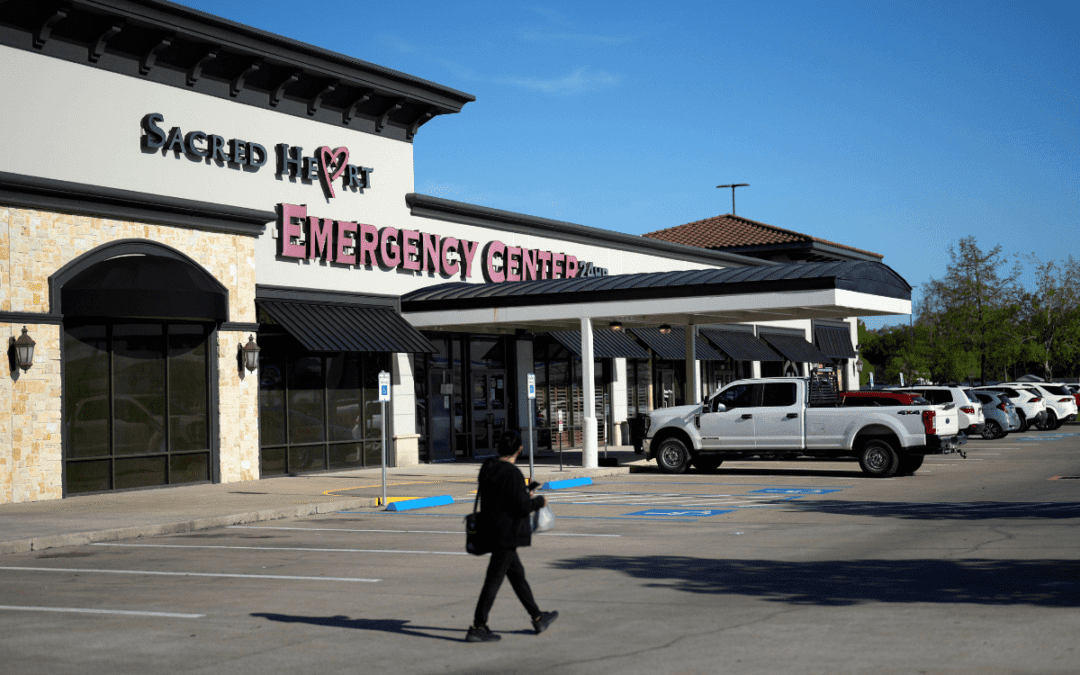
FAYETTEVILLE, NC - NOVEMBER 2: U.S. President Donald Trump delivers remarks during a campaign rally at Fayetteville Regional Airport on November 2, 2020 in Fayetteville, North Carolina. The state managed to swing to both President Trump and Democratic Gov. Roy Cooper in the 2020 election. (Photo by Brian Blanco/Getty Images)
Why the 2020 election shows NC is, strangely enough, getting more conservative and liberal at the same time.
A week after Election Day, two of Donald Trump’s most loyal supporters looked at the unofficial voting results in NC and noted something odd.
“Can someone tell us how the hell did (NC) Roy Cooper get more votes than President Trump?
Something smells very fishy and it ain’t tuna,” Diamond and Silk, the video-blogging entertainers and former Fox News personalities, posted on Twitter.
Well, Diamond and Silk, you’re right: That’s not tuna; it’s just North Carolina.
This purple state has a long history of voting for both Republican presidents and Democratic governors. It is a paradox indeed.
In the 14 general elections since 1968, the state has voted for a Republican president 12 times and a Democratic governor 10. In only three of those elections did NC elect Republicans to both posts. While North Carolina has now twice voted for both Trump and Cooper, it also voted twice for Democratic Gov. Michael Easley and for George W. Bush. And it is the state that voted for Gov. Jim Hunt, a Democratic figurehead, at the same time it voted for Ronald Reagan and Senator Jesse Helms, icons of the ultra-conservative movement.
The unique pattern highlights a deep diversity of views and a fierce independent streak, state political leaders and scholars say. But the 2020 election also shakes the pattern a bit, and blurs the national narrative casting North Carolina as a swing state that could tip either way on any given election.
An analysis of the 2020 results show a far more complex reality that highlights both NC’s unique history and the growing divisions of this rapidly changing state.
Of Two Minds
“North Carolina has long had this split personality,” Chris Cooper, the Robert Lee Madison distinguished professor of political science and public affairs at Western Carolina University, told Cardinal & Pine.
The paradox is in the state’s bones.
During the American Revolution, North Carolina divided evenly and heatedly between those wanting independence and those loyal to Britain. It seceded along with the rest of the confederacy at the beginning of the Civil War, then, just three years after losing the war, helped vote Ulysses S. Grant, the main military architect of the South’s defeat, into the presidency. And though North Carolina was hailed in the 1950s and 60s as a “progressive” beacon in the South, it had, according to a definitive study on the matter, more chapters of the Ku Klux Klan than any other state.
But, it was not until 1968 that the split began to show in its voting preferences. Until choosing Nixon that year, North Carolina had voted for only one Republican, Herbert Hoover, since before the 1900s. After 1968, NC has voted for a Republican in every presidential election other than Jimmy Carter in 1976 and Barack Obama’s first term. NC voted in large numbers for Lyndon Johnson, John F. Kennedy and even Adlai Stevenon. It never voted for Republican military hero Dwight Eisenhower.
But even in that watershed ‘68 election, NC still voted for a Democratic governor.
“A lot of that was similar to what was happening in the South more generally,” Cooper said. Political movements often start at the top of the ticket.
The Democratic to Republican shift – driven almost entirely by a resistance to the civil rights movement – completed itself across the South, but North Carolina stopped short of a full transition.
“We never completed this transformation,” Cooper said. “North Carolina got 90% of the way there and stalled.”
The last 10% held in the General Assembly, which Democrats held consistently until 2010. Now it holds primarily in the governorship.
Rep. Craig Horn, a Republican in the General Assembly from deeply red Union County, says the pattern fits NC’s quirky personality.
North Carolina is growing rapidly, he said, but it is also fiercely independent of outside forces, a trait, oddly enough that “is quickly absorbed by the people moving in.”
“Some of these issues seem like there is no consistency,” Horn said. “You’re wondering, How in the world can the populace vote this way, because it doesn’t make any sense? You can’t draw a hard and fast line. So that is indicative of this independence.”
The answers to the riddle, he said, may be simpler than they seem.
NC voters simply see presidents and governors differently, Horn said.
The presidency involves bigger, more ideological considerations like small vs. big government, trade policy and taxes. Constituents, Horn said, see governors as stewards of local priorities like roads and schools.
Robert Orr, a Republican former justice on the NC Supreme Court and one of the state’s most visible “Never Trump” conservatives, agrees.
“There has historically been and continues to be a pretty distinct difference between the hot button federal issues and bread and butter state issues,” Orr said.
“That is what a governor runs on, critical issues to folks here at home.”
And sometimes one issue becomes THE issue.

‘The Pandemic Effect’
While Gov. Cooper’s re-election fits NC’s running pattern, his decisive margin of victory may have less to do with the state’s unique political gene than it does with the unprecedented circumstances of this most rare election.
Despite sparse protests over his shutdown orders, Cooper saw high approval ratings for his handling of the coronavirus. His approach was in stark contrast to Forest, who, like Trump, dismissed masks and continued to hold public events during the height of the pandemic with little social distancing. But voters had several other metrics to judge Trump by. For many voters, Forest’s mask resistance was all they knew about him.
“I don’t think people are looking for a direct correlation between the number of infections or deaths and policy,” Chris Cooper said. “I think they are looking for what they perceive as a steady hand.”
The pandemic fight also gave Cooper a daily and highly visible platform, Horn said. Forest, who despite his statewide office was not widely known, could not keep up. “Dan Forest did not have the name recognition that us insiders thought he did,” Horn said.
Sometimes it’s just good to be the incumbent.
Power of the incumbency
“We can’t overlook, especially in a tight race, simple incumbency,” Cooper said. “All things being equal, we’d expect the incumbent to have a small advantage.”
If the results are any indication, the advantage was anything but small.
In the 2010 midterms, a volatile election pitting the new Tea Party movement against President Obama’s two-year old record, Republicans took control of the General Assembly, which had long been under Democratic control. A sea change, no question. But, in the same election, the state’s Congressional incumbents from both parties won all but one of their races, sending seven Democrats and five Republicans back to their national posts. (The losing incumbent was Bob Etheridge, a Democrat whose campaign was upended after a video showed him tussling with a conservative activist on a DC street, a scandal that seems almost quaint by 2020 standards.)
This is not a NC specific calculus, but in 2020, NC’s incumbents were especially dominant.
In the NC House, incumbents won 98 races and lost seven. In the state Senate, incumbents won all but one of their races. And in the Council of State, not a single incumbent lost.
This means that in all the races across the state pitting a challenger against the current office holder, incumbents won 155 and lost just eight. Whatever NC’s changing demographics may mean for future elections, preferences of the past are holding steady.
A Deepening Divide
“In 2008, the political world made a lot of NC going for Barack Obama,” Chris Cooper says.
“But of all the states that voted for Obama his margin in NC was the smallest of any of them. We were the reddest blue state in the country.”
Though Obama lost the state to Mitt Romney in 2012, Cooper said, Romney’s margin of victory in NC was the smallest in the country. “We were the bluest red state in the country,” he said.
With a mere 1.3 percentage points separating Trump and Biden, NC is again the bluest red state.
But, a look at the county by county results tell a deeper story.
As Diamond and Silk pointed out, Cooper got more votes than Trump, nearly 80,000 more. And Cooper’s margin of victory over Lt. Gov. Dan Forest was more than double that of Trump’s victory over Joe Biden. This seems to fit with the Democrats’ pre-election hopes that NC, without which Trump had no path to re-election, would help win back both the White House and the Senate, where Republican incumbent Thom Tillis trailed his Democratic challenger Cal Cunningham in most polls. There was even excited chatter about taking back the General Assembly.
In short, state and national Democrats hoped that NC would do what Georgia did.
It did not.
While Cooper won big, and Biden won nearly 500,000 more votes in the state than Hillary Clinton got in 2016, the state re-elected Tillis, voted again for Trump, and kept Republicans in charge of the state legislature. In the 13 open races in the House, Republicans won 10. Republicans also won 6 of 10 open races in the state senate. NC also chose a Republican Lt. Gov. and seems on track to have chosen a Republican chief justice of the state Supreme Court.
“It’s not that we have 100 purple counties that make a purple state,” Chris Cooper said. “It’s that we have an increasing number of red counties and an increasing number of blue counties.”
The purple, in many ways, is an illusion. The state is one of the fastest growing states in the country, and that growth lands mostly in the cities and trends blue. But, while the cities are getting more diverse, the rural areas are getting more conservative.
“Our counties are becoming redder and bluer, while the state remains purple,”
Chris Cooper said. “And that shift is happening right now.”
There are far more Republican counties in NC and the Democratic counties are far more populous. While the state may indeed topple blue one day like Georgia, many of these red and blue counties will never shift, a dynamic that has increased tension, accelerated polarization and muddied what it means to be a North Carolina voter.
“It is two hard concepts to hold in your head at the same time,” Cooper said.
“We are increasingly polarized and we are increasingly purple. At the individual level and the county level we are more polarized, there is no doubt about that . But we are increasingly living in separate political worlds within the same state.”
North Carolina is less a split personality, and more a crowded room with two distinct groups clamoring from either side.
“If you are outside the room,” Cooper said, “it sounds like one confusing chorus.”
The divisions are real and hardening, but the margins remain small.
“Our statewide elections were pretty tight, with the exception of Cooper, who didn’t blow out Forest the way some folks thought he would,” Chris Cooper said.
“Two things are true that you wouldn’t think would be true at the same time. The electorate in the last year has become slightly more Republican and the new voters are slightly more Democratic,” he said. “Each of those points tell you a slightly different story about the way North Carolina might be going.”
While Horn thinks that NC is less divisive than it is portrayed, the calculus is complicated for even partisan voters, at least at the margins.
“My constituents in Union County are overwhelmingly to the right of me,” Horn said, “and they put up with me because I work hard and am very accessible. And on the key issues I am in the right place for them.”
The key issues for the red counties, however, do not align with those in the blue. The clashing priorities, ideologies and interests can be stark, Horn said, but it is not all bad.
“When you see the incredible spread between Greene County down East and Mecklenburg County, they are two different worlds,” Horn said. “But both counties are populated by very loyal North Carolinians.”
He added: “I really embrace this difference among ourselves. That’s one of the reasons that North Carolina is so near and dear to me: North Carolinians in my view are on both sides of every issue.”
But, there can be no conversation about the future of the state, Cooper said, without discussing unaffiliated voters, the fastest growing registration bloc in the state. And it’s not a close contest.

‘The Mouse That Roared’
There are now more unaffiliated voters in North Carolina than registered Republicans, State Board of Elections statistics show. And soon, Cooper says, the unaffiliated will pass the Democrats. They also comprise the biggest percentage of voters age 18-45, a major demographic.
“It doesn’t mean they don’t have party allegiances,” Cooper said of these voters, “but it does suggest they are more moveable.”
Statewide battles are won and lost on the county level, and the numbers show that the unaffiliated voter made a big difference up and down the ballot.
In numerous counties in 2020, both the winning and losing candidates got more votes than there are registered voters in their party. In Guilford County, for example, there are 169,099 registered Democrats, 94,613 Republicans, and 118,437 unaffiliated voters. Biden won the county with 173,086 votes, to Trump’s 107,294.
Across NC’s 100 counties, unaffiliated voters outnumber Democrats in 34 counties and Republicans in 30. And they are the biggest bloc in 14 counties, including Wake, the second most populous county in the state.
“For a lot of these voters,” Cooper said, “in some subtle ways they are sending us a signal.”
“It really is the mouse that roared in North Carolina.”
In an article for The Asheville Citizen Times this year, Cooper wrote that unaffiliated voters are often registering for the first time, or have recently moved here. They are younger, more diverse, and less likely to be from North Carolina or even the South. “They represent a new breed of North Carolina voter,” Cooper wrote.
Paradigms Tremble, But Hold
North Carolina’s population is growing faster than all but three states in the nation. Much of that growth is centered in the Triangle and Charlotte, areas that are widely Democratic. In Wake County, Biden won by nearly 30 percentage points.
But while these Democratic strongholds had huge leaps in voter turnout, nearly every smaller red county had comparable per capita leaps. Nearly every rural county saw large per capita gains in voter registration and participation.
Alamance County, for example, went from 101,136 registered voters in 2016 to 110,925 in 2020. Voting participation leapt from 70.76% to just under 78%. And while Biden got 9000 more votes in the county than Hillary Clinton in 2016, Trump got more than 7,000 more votes than he did in 2016.
This trend is consistent across the red counties. In Yancey County, there were only 200 new voters registered since 2016, but participation rates climbed 8 percentage points. Democrats improved upon their 2016 totals across the state, but Republicans improved more.
In Rep. Horn’s Union County, registered voters grew by more than 17,000 and voter participation moved from 70 to 78%. Biden won 14,388 more votes than Clinton, but Trump improved by 13,675. Republicans in the county did not lose a single race to a Democrat.
In 2020, Democrats in NC turned out in historical numbers and Republicans won more votes in the state than in any other election. Two seemingly contradictory things true at the same time.
So who are the Cooper/Trump voters and what do they reveal about the state moving forward?
Like with all riddles, the answer is evasive and full of contradictions.
“The Trump/Cooper voter is the white whale of NC politics.”
Chris Cooper
“In poll after poll, 8 to 12% of voters said they would vote for both Cooper and Trump,” Chris Cooper said.
Politics often wants an easy answer to big questions. Who was the deciding voter? What demographic tipped the scale, which one gets the blame for a loss? But, there is not one voter anymore than there is one North Carolina. Sometimes there is no answer, which is kind of what makes it a riddle in the first place.
“The national media and national political observers have made a lot of conclusions over some very small movements,” Chris Cooper said. “They have over concluded based on movements from blue to red. North Carolina is still going to be a battleground going forward,” he said.
“The reality is, we are on the side of a razors’ edge every time.”
Politics

Emergency rooms refused to treat pregnant women, leaving one to miscarry in a lobby restroom
By AMANDA SEITZ Associated Press WASHINGTON (AP) — One woman miscarried in the lobby restroom of a Texas emergency room as front desk staff refused...

‘Unfit to be our next governor’: NC basketball greats speak out against Mark Robinson’s run for governor
NC has a long history of greatness on the basketball court. Now college basketball players from UNC, NC State, and Duke are wading into politics....
Local News

Good News Friday: It’s a good day to be a fan of the NC State Wolfpack
The men's and women's teams will compete for a national championship in college basketball this weekend. Plus: How to watch the solar eclipse, and...

The zodiac signs of 12 iconic women offer insight into their historic accomplishments
Zodiac signs can tell you a lot about someone’s personality. Whether they’re an earth, water, air, or fire sign, these 12 categories (which are...





